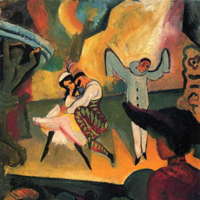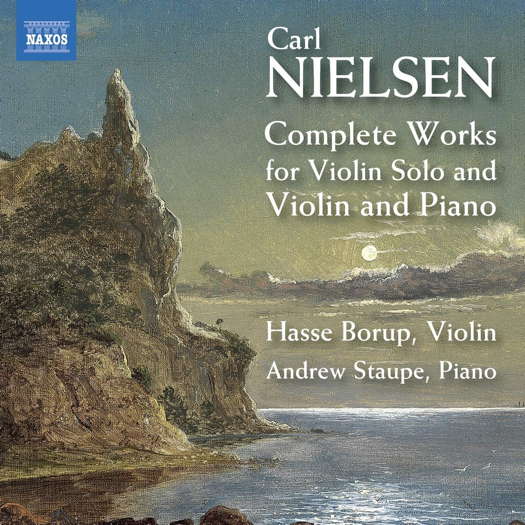- Britten: War Requiem
- Wang Kun
- payment
- Alan Oke
- Aleksei Maslennikov
- Tomás Victoria
- Christian music
- Shaker melodies
 ROMANTICISM: Explore the late George Colerick's fascinating series of articles encroaching on the subjects of melody, romanticism, operetta and humour in music.
ROMANTICISM: Explore the late George Colerick's fascinating series of articles encroaching on the subjects of melody, romanticism, operetta and humour in music.
 CENTRAL ENGLAND: Mike Wheeler's concert reviews from Nottingham and Derbyshire feature high profile artists on the UK circuit - often quite early on their tours.
CENTRAL ENGLAND: Mike Wheeler's concert reviews from Nottingham and Derbyshire feature high profile artists on the UK circuit - often quite early on their tours.

Changes of Mood
GEOFF PEARCE is impressed by Carl Nielsen's music for solo violin and for violin and piano
'The performances are of a high standard, as one would expect, and violinist Hasse Borup and pianist Andrew Staupe play the music with great affection and attention to detail.'
I looked forward to this disc as for many years, I have loved the music of Carl Nielsen, and I knew that he was an accomplished professional violinist as well as a composer, and had not heard any of his violin works before. The works were not played in any particular chronological order on the disc, but the interesting accompanying booklet lays out the information according to the compositional date. If I was producing this disc, I may have followed the booklet order so that the listener could follow Nielsen's development of compositional style.
The first work on the disc is the first Violin Sonata in A major, written in 1895. This was written just after the premiere of Nielsen's First symphony. It was not particularly well received (as has been the case with much of his work) but it did have its champions. It is a substantial work lasting twenty minutes and is in three movements.
The first movement starts off in a very positive fashion with a soaring violin part. It is generally positive but has frequent tempo changes, and changes of mood that give it an expansive but restless nature.
The second movement is heartfelt and elegiac in nature, at first pensive and sorrowful, but then there is a beautiful tender section, at first introduced by the piano, before the violin enters. It gradually becomes more impassioned. The overwhelming mood is reflective and pensive with a somewhat impassioned and brooding quality.
Listen — Nielsen: Andante (Violin Sonata No 1)
(track 2, 1:42-2:19) © 2020 Naxos Rights (Europe) Ltd :
The third movement is full of optimism and vitality, except when it slows down and becomes tender, but this does not last long, and its happy but restless nature soon reasserts itself. There are a number of contrasting sections to this movement (and indeed this is often a feature of Nielsen's music generally). I found that this sonata's charms do not reveal themselves fully at first hearing, but after listening a few times I am amazed that this work is not more often performed.
Listen — Nielsen: Allegro piacevole e giovanile (Violin Sonata No 1)
(track 3, 4:17-5:13) © 2020 Naxos Rights (Europe) Ltd :
The second sonata, written over the period 1912-19, is also a three movement work, and is about the same length as the first sonata. The first movement has a great number of changes in mood and tempo. This gives it a somewhat restless nature, at times resolute, at other times rather agitated and stormy, and at times very tender.
Listen — Nielsen: Allegro con tiepidezza (Violin Sonata No 2)
(track 4, 6:59-7:50) © 2020 Naxos Rights (Europe) Ltd :
The second movement is quietly brooding, and there is an underlying dramatic quality that never quite exerts itself. The rhythmic pulses, which gradually subside, are what drives this movement. There is a melancholy feel to it, which at times brightens.
The last movement is the shortest. I find this dance-like movement somewhat bittersweet but the overall character is one of optimism. It has the strangest ending of any violin sonata I have heard.
Listen — Nielsen: Allegro piacevole (Violin Sonata No 2)
(track 6, 2:20-3:00) © 2020 Naxos Rights (Europe) Ltd :
Prelude, Theme and Variations (1922-23) was written during what was probably Nielsen's most experimental period. It was composed for his son-in-law, Emil Tlmanyi, and was inspired by the Bach Chaconne. With its florid violin writing and expansive gestures, one can sense this, especially in the opening prelude. At that time in his life, he also liked composing songs for massed communal singing. This characteristic is evident in the theme.
The variations that follow the theme are technical show pieces and the violinist has the opportunity to display many of the techniques, such as may be used in many of the Paganini Caprices. Some of the variations are technical show pieces and others highlight the performers' expressive powers.
Preludio e Presto was composed in 1927-28 as part of a tribute for the sixtieth birthday of Danish composer Fini Henriqes. This is a technically demanding and very interesting work which has a strange remoteness about it that is quite compelling, especially in the Preludio.
Listen — Nielsen: Preludio: Con fantasia (Preludio e Presto)
(track 18, 2:47-3:44) © 2020 Naxos Rights (Europe) Ltd :
The youthful Sonata in G major, written when the composer was about fourteen, is a short work of about eight minutes. It is firmly in the mould of Mozart, and if I was not told, would have truly believed it was written by a composer towards the end of the classical period, so convincing is young Nielsen's writing. It is a charming little work that is very well written.
The final works on the disc are very short, and include two charming Romances written in the late 1880s when the composer was in his early twenties. These unpretentious simple songs last about three minutes each and I am sure would have been well received in the salons of the time.
There are two little tracks to finish this disc off. The first, a polka that Nielsen wrote when he was somewhere between seven and nine, was not written down but recalled somewhere about sixty years later. It is for solo violin and is very folksong-like.
The second fragment, 'Gruss', is even shorter and was included in a book of greetings to a young girl who he taught whilst he was lodging with her family in the mid 1880s.
This is a disc that I like very much. It contains works of Nielsen that are not often heard widely outside his own country. The performances are of a high standard, as one would expect, and violinist Hasse Borup and pianist Andrew Staupe play the music with great affection and attention to detail. This is certainly a disc to treasure.
Copyright © 5 October 2020
Geoff Pearce,
Sydney, Australia

CD INFORMATION: NIELSEN WORKS FOR VIOLIN SOLO & VIOLIN AND PIANO
FURTHER INFORMATION ABOUT CARL NIELSEN
FURTHER INFORMATION ABOUT NAXOS
FURTHER ARTICLES ABOUT DENMARK


